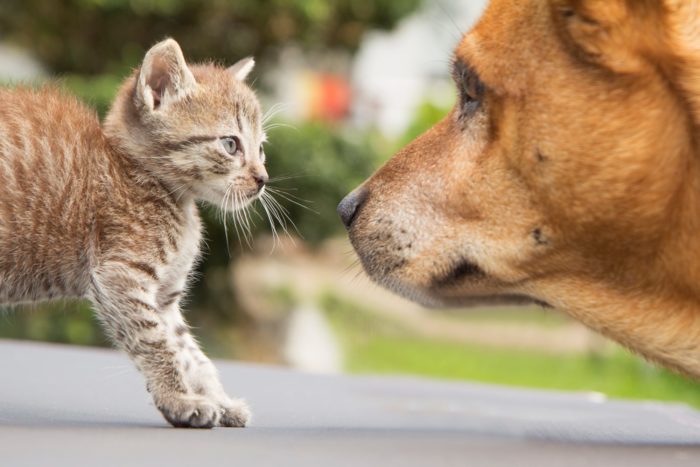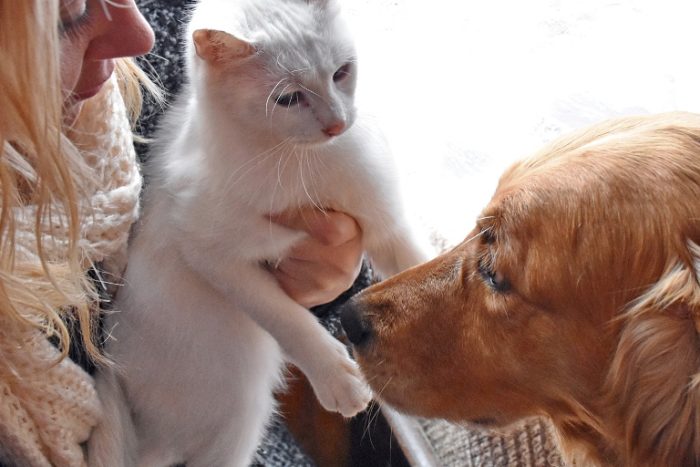Pet parents who wish to transform their single-pet homes into multi-pet households have a lot of things to consider before bringing in a cat to join the resident dog or getting a dog as a companion for their feline friends. These two animals may not mix well if not well introduced and may end up causing each other bodily harm, thus, animal behavioral experts have rolled out some workable rules to follow in such situations. To perfectly introduce your dog to a cat, the right process must be followed.
Table of Contents
The Importance of Scent
For the members of the canine and feline population, “smell” is an extremely vital aspect of communication. While integrating a new pet into a multi-pet home, ensure that it smells like home before bringing in the other pets for the introduction. This process can even commence before you bring home the new pet – if possible, their beddings can be exchanged while the incoming pet is still with the breeder. This way, both cat and dog can familiarize themselves with each other’s scent before the actual introduction.
Early Days
Even as they are now familiar with each other’s scent, it is recommended that you keep both pets separated once you bring in the new addition. They shouldn’t go exploring on the first day – either cat or dog would need ample time to familiarize themselves with the new surrounding and do some adjustments. If you have not already done the scent swapping, this will give you enough time to do so. As earlier mentioned, it can be carried out with regular bedding swapping and you can stroke the two pets one after the other without washing your hands.
Some people would gather the new pet’s scent with a towel and dab it around their house furniture to mix with the scent of the existing pet. This scent swapping may delay both cat and dog from meeting for up to one week. If the incoming pet is a cat, let it explore the surroundings in the absence of the resident dog.
To introduce your dog to a cat, pet parents may also consider keeping the pup in a dog crate where it can be seeing the cat as it explores – this way, they can directly smell each other without the possibility of a bad encounter. Under this condition, the dog won’t be able to give a chase even if it badly wants to and the cat can safely explore around the resident dog knowing that it cannot break free.
Early Introductions Between Cat and Dog Must Be Controlled

Before that actual face-to-face stage when you want to introduce your dog to a cat, ensure that your dog has gone through the necessary obedient training and can respond swiftly to commands and cues. However, even with the obedient training, the dog must be leashed at the first meeting as you command it to sit and remember to reward his response with plenty of treats. As this is going on, the cat will be wandering around the leashed dog. They may decide to ignore each other or sniff each other; both are good signs of progress and both pets must be rewarded with treats for good behavior.
On the flip side, if the canine begins to stare intently at the new cat, whines, or barks anxiously, then it is time to redirect its attention with treat, toy, or the sit or lay cue. Bringing in the treats and toys is what will make being around each other a positive experience and with time, both pets will start looking forward to the next time.
Special care should be taken with kittens.
A new kitten is more likely to adapt to a resident dog faster than an older cat because they generally tend to be bouncy, playful, and fearless. However, their small but active body may make the dog mistake it for something to chase or grab. Recommendations from experts are that no kitten should be left completely alone with a dog, not until the pet parent is sure that the kitten would be safe with the dog.
In fact, leaving a new cat with a dog, even if it is a full-grown cat is not recommended, unless the owner is on hand to supervise their interactions. When you are going to be away from home, ensure that they are separated in safe places.
Living Together

As the familiarization process continues, the resident dog and incoming cat may learn to tolerate each other. With luck on your side, they may become close friends that play and snuggle together. However, we have seen cases where cats and dogs never learned tolerance and in this type of situation, they should never be left alone unsupervised. The pet parent should always use observations to judge when it is safe to leave both pets alone as being safe is far better than being sorry.
The outcome of the introductions notwithstanding, every pet parent who wishes to run a multi-pet home must always ensure that their home is set up in such a way that the cat can always retreat into a dog-free zone. The new feline’s litter box, food, and water should be kept in places that are inaccessible to the dog. If you are the type that spends a long time outside the home, then, your dog must be crate trained – this will ensure the cat’s safety in your absence.
Whichever way the pendulum swings, it is recommended that you give both pets a lot of physical and mental stimulation like exercise, training, playing with toys, etc.
Read Also: 10 Worst Dog Breeds For Children: These Dogs Are Less Toddler-friendly
Rules To Follow To Introduce Your Dog To A Cat

- If you are thinking of keeping both cats and dogs in the same household, you should first consider the personalities of both animals. Recommendations are that you go for a cat that has a record of exposure to dogs or a dog that has interacted with cats in the past.
- If your dog has a high prey drive and is likely to aggressively chase, grab, pin, or manhandle any cat, then say goodbye to the possibility of running a multi-pet home. However, if you insist to proceed, you must do so with loads of caution. Remember, any dog that obsessively barks, growls, or lunges at a cat is best reared in a cat-free environment – the same is applicable to a cat that has the tendency to lunge at a dog.
- A dog that loves giving chase will be a very wrong choice for a shy and fearful cat that takes to its heels at the slightest provocation; the cat’s behavior will only serve as a trigger for your dog to give chase. In the same vein, an energetic cat that pounces and runs won’t be good for a quiet dog. For a better match, consider adopting a calm, confident cat that won’t scurry into the shadows out of fear. In other words, it’s best to introduce your dog to a cat that matches its personality traits.
- If your canine companion is the type that engages in rough play, then avoid adopting kittens or elderly cats that can get hurt easily. Your choice should run to playful adults that have enough confidence to take care of themselves. Matching a gentle but playful dog with a rambunctious cat won’t be a bad idea.
